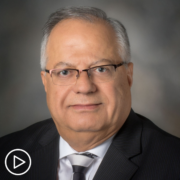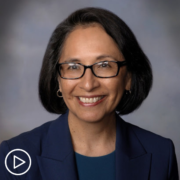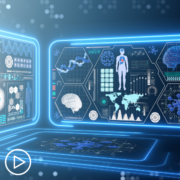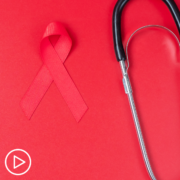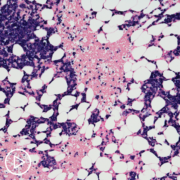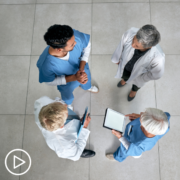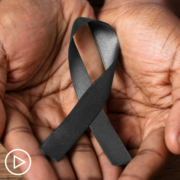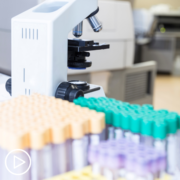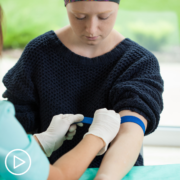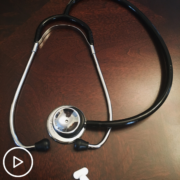Thriving With AML | Tips and Support for Navigating Treatment
Thriving With AML | Tips and Support for Navigating Treatment from Patient Empowerment Network on Vimeo.
Related Resources:

|

|

|
Transcript:
Katherine Banwell:
Hello, and welcome. I’m Katherine Banwell, your host for this webinar. Today’s program is about how to live and thrive with AML. We’re going to discuss how to live well with AML and why you should play an active role in your care. Before we get into the discussion, please remember that this program is not a substitute for seeking medical advice. Please refer to your healthcare team about what might be best for you.
Well, let’s meet our guest today. Joining me is Dr. Jacqueline Garcia. Dr. Garcia, welcome. Would you please introduce yourself?
Dr. Jacqueline Garcia:
Yes. Hi. My name is Jacqueline Garcia. I’m an oncologist at the Dana-Farber Cancer Institute. I’m a clinical translational investigator. And what this means is I take care of patients with acute and chronic leukemias. I focus mainly on patients with acute myeloid leukemia. The investigator part means, in addition to seeing patients, I spend a lot of time writing, developing, and executing clinical trials in the AML space. We know that there have been so many wonderful therapies that we helped to move froward and bring to the field and so there is more work to be done. So, having active investigations is a key part of this role.
Katherine Banwell:
Excellent. Well, thank you for taking the time out of your schedule to join us today. We really appreciate it. We start all of our webinars in our Thrive Series with the same question. In your experience, what does it mean to thrive with AML?
Dr. Jacqueline Garcia:
I think that’s a really great question and I’m glad you’re asking me now as opposed to a decade ago. In the last several years, we’ve had a tremendous number of drugs that got FDA-approved and a lot of exciting clinical trials that have not only shown efficacy and safety but really some long-term responses. So, we can now focus on not just finding what drug can work, which used to be our problem 10 years ago, since we had very limited therapeutic tools, meaning treatments. We now have several treatments available.
So, when I think of what it means to thrive, it’s identifying the right treatment for each individual patient with acute myeloid leukemia, because what might be recommended for one patient may not be the right for another. And there are many different patient- and disease-related factors that go into that decision-making.
Katherine Banwell:
Thank you for that, Dr. Garcia. It helps guide us as we move into our conversation. Typically, there are a number of team members to care for a patient. Who is part of an AML healthcare team?
Dr. Jacqueline Garcia:
Absolutely. We definitely cannot work on our own. Our team is very large, and it’s because these patients require a lot of support. At a bare minimum, a healthcare team will include at least one physician or an oncologist. The AML healthcare team might also include a second oncologist – that could be a bone marrow transplant doctor.
Other members that are very critical include having a mid-leveler available that’s a physician assistant or a nurse practitioner. Often, an oncologist who runs a busy practice, who takes care of patients that could be very sick, like AML, they work in partnership with often very talented physician assistants and nurse practitioners. I know I do.
In addition to that, I’m at an academic center so I’m super fortunate. I have really amazing and very smart hematology oncology fellows and residents that also follow to learn how to take care of patients. But we also, in the background, that patients don’t see – we have a pharmacist that helps us with making sure that drugs are prescribed correctly. They often call the patients with oral therapies to follow up. We have financial resource teams to help patients, to link them to LLS for support for bills that might come up, or transportation, or linking them up to other services that could help to defray or reduce costs.
So, the healthcare team is quite extensive. But in terms of those that are patient-facing, it’s primarily the MDM that are mid-leveler. Some teams operate also with a nurse or a nurse care coordinator. That’s pretty common, too. And that person helps to not only schedule but also to answer pages or phone calls from patients if the medical team is not doing that.
Katherine Banwell: What about a social worker or psychologist?
Dr. Jacqueline Garcia:
Oh. Yes. Yes. So, absolutely. So, every patient can be offered, if needed, access to an inpatient or outpatient social worker. Often, if my patients are admitted we have them see a social worker because that’s fairly seamless. Otherwise, for outpatient, if we identify any particular needs or there’s an interest, we’ll link them up with a social worker. This is the same that goes for physical therapy, or nutritionists, or those other ancillary services that can be really critical when patients are getting started.
Katherine Banwell:
Yeah. Of course, getting appropriate care and treatment is essential to thriving. Can you walk us through the classes of treatment that are considered when choosing an AML treatment approach?
Dr. Jacqueline Garcia:
Yeah. In terms of the different classes of treatments, I would say we think of probably three broad categories. One would be – sorry, four broad categories. One would be intensive chemotherapy. And that involves generally hospitalization. Another would be less intensive therapy. That could involve a mixture of inpatient or outpatient therapy. That could also include targeted therapy. The third would be clinical trials, which can include any of the former options I recommended, but they would be in an experimental study. And the fourth would be focusing solely on supportive care or hospice for patients that are too sick to receive therapy.
Other aspects that are specific, such as pills, versus IV, versus role of transplant, I don’t see it as being separate. You don’t go right to transplant when you have a diagnosis of AML. You have to be in remission. So, transplant, for instance, would come after an intensive therapy or after the less intensive chemotherapy. So, I see that as being the second step once I choose the right treatment option for the patient.
Katherine Banwell:
And when you’re talking about transplant, you’re talking about stem cell transplant, right?
Dr. Jacqueline Garcia:
Yes. Stem cell transplant, bone marrow transplant – they mean the same thing. We recruit stem cells from donors that are related or unrelated, and we mobilize them from bone marrow to blood. And so, we can collect stem cells either from blood or bone marrow at this point. So, that’s exactly right.
Katherine Banwell:
And what about targeted therapy?
Dr. Jacqueline Garcia:
We have targeted therapy available that’s IV or pill form. And so, any one of these options can be considered. But everything is very patient-specific, and I am very happy to tell you some of the categories and nuances of things that I look at, because I don’t usually just offer patients a menu.
I tell them what’s appropriate based on their patient characteristics, meaning what their liver function is, their heart function, their history, medical history, what their labs show. And then, I look at their disease history. We are now in an era where we have options. So, I look to see are there mutations that are targetable. Are there not? Are there markers on the surface of their leukemia cells that suggest that there’s a target for an immunotherapy?
So, we don’t offer classes per se without it being specific. So, I always look to see what are the patient disease-specific characteristics, and then I start the conversation about what the potential options could be and then what I think the best option would be for that particular case.
Katherine Banwell:
As a researcher, Dr. Garcia, you’re on the frontlines of AML treatment. Are there new and emerging therapies that patients should be aware of?
Dr. Jacqueline Garcia:
Yeah. I think we’re at this really exciting point now where we had for a long time just been giving people standard two agent intensive chemotherapy. We have been studying in Phase II and Phase III settings, and even in Phase I – which means testing safety out for the first time. We’ve been moving a lot of treatments to more mature settings where we’re testing the addition of a third drug. So, for people that are getting intensive chemo, we’re looking at, “Can we add a pill to augment responses deep in them to reduce risk of disease returning?”
For less intensive chemotherapies, one of the most common regimens we now use is something called azacitidine (Vidaza), which is a hypomethylating agent that is given by IV or subcutaneous administration. Plus, a pill called venetoclax (Venclexta).
We helped to get that FDA-approved a couple of years ago. That combination of therapy, we call that a doublet, meaning it’s two drugs – because it’s so well-tolerated and active, we’re now asking the greedy question of, “Well, can we make it more active for patients since we’re seeing how well-tolerated it is?”
So, there have been a lot of therapies that are currently under investigation that are adding a third drug to these less-intensive doublets. So, there’s a lot of therapies under investigation to test, “Can we add an immunotherapy target? Is there another pill that we can add? Is there another targeting mutation to add to the doublet?” So, we’re looking at AML therapies from different angles. We’re looking at adding something to the existing new standard of care – those are these new, so-called, triplets.
We’re looking at still the role of cellular therapy or CAR Ts targeting leukemia cells from an immunotherapy standpoint.
That remains underdeveloped overall, and we have not succeeded as well, like our lymphoid colleagues in the lymphoma and acute lymphoblastic leukemia realm where there are drugs that are active and FDA-approved.
So, we’re still trying to identify the right target. But those are some of the areas that are currently under study.
Katherine Banwell:
You touched on this earlier, Dr. Garcia, but I’d like to get into a bit more detail. With all the treatment options available, how do you decide who gets what? Tell us what is considered when choosing treatment for a patient.
Dr. Jacqueline Garcia:
When I – this is a complicated question, because it’s not like you follow any particular algorithm. But when I meet a patient, I make a decision on what’s important to the patient and what’s their goal. If I know – I need to understand their overall health to get a sense of are there ongoing competing risk factors that are active and more likely to impede with response, ability to deliver chemo, ability to get to transplant, something that tells me that’s not a possibility, or is their age too advanced – meaning greater than 75 – where we know that some of the treatments are not safe to deliver in that setting?
So, I take a look at a patient’s overall health and age to make a decision. I take a look at bone marrow biopsy and lab findings to understand the flavor of their leukemia, from chromosomes to mutations. And because I am familiar with the data to give me a sense of what’s safe, what’s tolerable, and importantly what types of diseases, or subtypes of AML, would respond to one therapy over another, that’s how I formulate a recommendation.
And based on all of that, all together, I’ll talk to them about treating the AML in steps. The first step is getting them into a remission, which can be done regardless of therapy type. That means to get their bone marrow under control, blood counts to recover. The second step, which is a more involved conversation that I often give a little bit of a hint of, but I go into greater detail over time, because we will see each other quite a lot, whether in the hospital or in clinic, is how to keep them in remission.
And that’s where details about things like transplant come into play. I do my best to not overwhelm them, because when a patient hears the word transplant – and that’s often what they hear from family and friends because that’s what you can Google – they don’t know that there are many things, or many weeks of therapy, that have to happen in advance of transplant even being considered or happening. And transplant can’t even happen until someone’s in remission.
But that is always on the forefront of a leukemia doctor’s mind, “Can I bring this patient to a transplantation? How successful will I be and what else do I need to give them to get them there sooner, safer, with a deeper response?” So, that way transplant could be successful. Transplant, by the way, is when we give a patient someone else’s stem cells that match their HLA typing, or their white blood cell signature.
And it helps us to use someone else’s immune system to completely irradicate any microscopic leftover leukemia in a patient. But that is only successful when patients have good disease control or remissions. And that is only also successful if we have a donor for the patient, both of which require at least several weeks to a couple of months of therapy. But that process is always initiated and ongoing in the background. And so, we often do this in piecemeal, because getting a diagnosis is already overwhelming. Learning about treatment is overwhelming.
Learning about the frequency of labs, transfusions, being hospitalized, and then details about what a transplant would entail can be also overwhelming. But a lot of family and friends like to ask, because they feel like that is one way they might be able to help a patient. So, I know that they often eagerly ask the patient, “Well, what about this? How can I help?”
Katherine Banwell:
Right. I can imagine that patient preference is also considered. But what kind of questions should patients ask about their treatment regimen?
Dr. Jacqueline Garcia:
I always tell patients that I care very much about things like travel, hotels, all that jazz. But I always tell them let’s first talk about their health, what treatment I would recommend based on the available options and what their disease would mostly respond to, because I want it to be successful. And I always tell them let’s reserve questions on how it’s going to be done for last. I call that the logistics. I will never bring up or recommend something that could never be possible. But that being said, I try not to let the commute determine the decision.
Whether or not there needs to be a hospitalization versus a hotel stay. I always consider then the background, but that financial decision should not drive the best treatment choice for a patient. Very fortunately, we’re in a country where patients have the ability – often, not always – to seek second opinions or to travel to academic centers.
And because AML is an emergent or life-threatening disease, many insurance providers allow patients to come up to a big center to be treated, which I think is more than appropriate. So, we get into details of logistics last, because that’s the one thing that we can often overcome by providing additional resources and support. In terms of patient preference, if that’s what you mean with that, I would say I leave logistics to last, but we always consider and we do our best to accommodate.
And that might be where we inform them we will look into getting a local partner to help us with additional therapies after the first month or upon discharge. So, it totally depends on the scenario for a patient, whether or not they have a local provider and a local hospital that could accommodate acute leukemia. I always tell patients ideally you don’t want to go to a place that only sees this once per year. You want to go to a place where everyone has seen it multiple times, including the nurses on the floors.
So, that way, when there’s a complication, everyone knows what to do. We don’t want any “surprises” when it’s really just run-of-the-mill standard stuff for us every day. In terms of what patients desire, we always keep that in the conversation of their level of support. Can they swallow pills? Are they able to cope with being in and out of the hospital? All that stuff gets considered, but I think if they hear about the plan, about what’s required, when my expectation would be for a response, when the frequency of trips to a big city would decrease, how I could get a local partner to help with some of the lab or transfusion burden.
Many of those preferences that they thought they had diminished, because they recognize that we found a way to make it work.
Katherine Banwell:
Okay. Well, that’s really good to know. You touched on oral therapies a bit ago, and I know that they’re available for certain patients. Do you have any advice for patients who are in charge now of administering their own therapy?
Dr. Jacqueline Garcia:
Yeah, I think that taking pills in general is hard for anybody, whether they’re naïve to pills. I definitely have patients that have never been on anything, and suddenly they’re on many medicines, to other people that are managing multiple medical conditions and this is yet another burden to add. I would say having an oral regimen is wonderful. It offers a lot of convenience. But we are all very thoughtful, and we all need to be proactive about looking for drug-drug interactions, because often there could be increases in the chemotherapy presence when another drug is on board.
Sometimes, antibiotics are added on but they don’t realize it can add to side effects to chemotherapy. So, I would say number one is always make sure your oncology team is aware of the medications you are on or get recommended to add on in the midst of therapy, so we can make sure there are appropriate dosage estimates or if a particular drug should be avoided, then we can do that.
I would say, too, having oral therapies is great, but there’s also financial toxicity that comes with it. Sometimes copays can get hefty. So, just because it’s oral, it’s not always convenient financially. Also, when things are oral it can add to more GI or mal gut toxicity. So, we’re always keeping in mind how many oral therapies, what drugs they are, so we don’t increase nausea and diarrhea, which can happen frequently when you’re requiring the GI tract to absorb the therapies that are necessary to eliminate the disease.
So, all these things are under consideration. But to help people that are on oral therapies, it’s helpful to let your providers know if you’re noticing a pattern of nausea, so we can premedicate, have you take a nausea medicine before you take the chemo. You could also put a timer on your phone if you’re not used to taking medicines to serve as a reminder. You could create little calendars or check off on a paper calendar when you’ve taken a drug if you need help with reminding.
So, there are little tricks like that. I always consider using a pillbox if you don’t have other pills to mix in and if you’re the only one touching it. I don’t want anybody to be exposed to therapies that they shouldn’t be otherwise.
Katherine Banwell:
That’s good advice. Thank you. If a patient is feeling uncomfortable with the direction of their treatment plan or their care, should they consider a second opinion or even consulting a specialist?
Dr. Jacqueline Garcia:
Oh, 100 percent. I would say – I think that I’m spoiled. I’m a leukemia specialist, so they’re already seeing a specialist when a patient sees me. I don’t take care of any other cancers. But, I would say, for anyone seeing any oncologist in general, I would – number one, it doesn’t do the medical team any favors if you withhold any feelings of how the treatment’s going. Meaning, if you feel uncomfortable or that you’re having symptoms or people are taking too long to get back to you based on your experience.
I would just make sure you do your best to at least let them know so that they have the ability to adjust or accommodate whatever need you might have that might be different than what they’re used to, because every patient’s different. Some people have a really great support system. Or they have a little bit of experience of being a patient. Different coping mechanisms. Everyone’s different. There’s no right or wrong. But I would just make sure that it’s clear with your existing team because they’re actively seeing you. Give them a chance to make the experience better.
I would for sure seek a second opinion. Don’t delay – I will just put this disclaimer. I would not delay treatment for an AML if your current doctor is giving you a good plan and you feel confident that they have looked into whether or not you need to go to a bigger leukemia center and all that other stuff. But if you feel like they are giving you a good plan, don’t delay your therapy in the beginning, because you might get sick.
If, however, there is demonstration of safety and time to see someone within a short timeframe for a second opinion at the time of diagnosis before treatment started, then that’s okay. But wouldn’t wait a few months to go looking around, because that could put your health at risk. Once you’re on treatment, seeking a second opinion, if you’re dissatisfied with your ongoing team, it’s fine. I always want patients to feel comfortable with their treatment plan.
But I would recognize that you want to make it clear to your current team that they’re still helping you and responsible for your treatment. Because if you, for instance, started seeing multiple doctors and they won’t know who should be helping to follow up on certain things, who’s going to be scheduling the next round of therapy. And that ends up putting more ownership unnecessarily onto the patient where they might not have needed to have all that extra responsibility. So, I would just say just make sure that’s clear. Yeah.
Katherine Banwell:
Dr. Garcia, you mentioned earlier the fact that some therapies can cause a lot of side effects, like nausea. And certainly, speaking up and telling your healthcare team how you’re feeling and what some of the symptoms and side effects are, that’s really essential. What is the impetus for someone to consider changing treatment if something is just absolutely not agreeing with them?
Dr. Jacqueline Garcia:
So, there are many reasons to change a treatment. One is a patient doesn’t tolerate it. It depends on what the issue is. Is it something that’s serious, like a liver or enzyme abnormality that is very abnormal, or a new cardiac problem where it would warrant a change or a dose reduction? That makes sense. There is definitely – often, there’s a lot of guidance in the package inserts or within a clinical trial and how to manage that. But if patient has some intolerabilities that could be overcome with standard supportive care methods, I would make sure we’ve done that.
So, I would make sure you give you medical team the chance to fix any nausea. We have so many great antinausea drugs. I would want to make sure – or if constipation or diarrhea. It’s often a GI issue that patients get really bothered by.
I would try to delineate whether or not the side effect was really from the chemo or is from the leukemia that is not yet under control. Or is it another medical condition or a drug-drug interaction that was missed. So, I would do my best to make sure there wasn’t something that was fixable or something else that should be addressed. We otherwise would recommend changing therapy for an extreme intolerability if there was another equivalent better option. And if someone’s disease does not respond to treatment, then we would consider another therapy, too.
Katherine Banwell:
Dr. Garcia, I want to make sure that we get to some of the audience questions that were sent to us prior to this program. Let’s start with this one.
Jerry had this question. “How long can patients stay on azacitidine and venetoclax before relapse or toxicities force them to abandon treatment?”
Dr. Jacqueline Garcia:
So, this is a good question. I would say azacitidine and venetoclax just got FDA-approved just shy of five years now, and it’s totally changed our treatment paradigm in many great ways. It was initially approved for patients that could not get intensive chemotherapies or were above 75. We call these our older patients, our more vulnerable.
And we demonstrated and compared to azacitidine alone. It was given with placebo. We saw that the combination of azacitidine and venetoclax not only was safe, well-tolerated, it led to two-and-a-half times higher complete remission rates and impressively longer survival. That’s all we care about, patients are living longer. So, one of the things that we are appreciating in 2023 now, now that we have more patients on azacitidine and venetoclax, is that we have many patients that are long-term responders.
So, in the original clinical trial we’ve been reported – and we just submitted the update for the long-term follow-up that we presented at the American Society of Hematology meeting in 2022, in December.
We presented the long-term follow-up data that shows that responses can be durable and even as long as two years or three years in some patients. The average amount of time the patients are on therapy is somewhere between one-and-a-half to two years. But not every patient performs like an average patient.
We have some that respond for less time. We have some that respond for a longer time. So, I definitely have a few patients that have been on combination therapy, and we’ve gone to year three, then four, and two that got to year five. And that was using the original indication of older the 75, no intensive chemotherapy. Most of those patients in the original trial and led to the approval were not transplant candidates. But once those drugs got approved, more patients that were older started getting this therapy.
And so, the durability of this treatment might be longer for people that don’t have competing health problems and for specific mutation subtypes. There are a couple of mutation subtypes that include IDH2 and NPM1, where we’ve seen some extreme long-term responders.
And then, there are others that are much shorter. So, I would say it’s very individual. In terms of toxicities in general, the regimens very well-tolerated. And if it’s not, often it’s because there should be supportive care, prophylaxis, and adjustments to the dosing strategy, which has been well-published. Sometimes, if you have a treating oncologist that is less familiar, they won’t know the nuances of how to adjust the doses, so I would ask your local oncologist to reach out to anybody that was part of the original trials. Often, a lot of us are very responsive to helping out our colleagues to help patients to stay on treatment.
But at the end of the day, if a patient loses response or has a bad toxicity that makes it very difficult, we have to move on to another therapy.
Katherine Banwell:
Of course. Carrie sent in this question. “What percent of patients relapse and what percent of patients relapse more than once?”
Dr. Jacqueline Garcia:
Okay. So, this is a question that I can certainly answer, but I would say it depends on the context. So, if I was taking – any time a patient asks me that, I always ask them what they want to know and what they don’t want to hear, because sometimes hearing numbers can be really daunting to patients overall.
So, a very large number of patients with leukemia can go on to relapse, which is why, if you’re on a treatment like azacitidine and venetoclax, we continue it every month as long as we can with dose reductions to help with tolerability.
And that’s why, if you got that regimen or intensive chemo or another clinical trial and you get into remission, we ask the question of can we transplant this patient to do our best to cure them long-term to avoid and reduce the chance of a relapse. So, even with transplant, which remains our gold standard for long-term curability – it’s the only treatment we have that has a guaranteed track record of cure – not every patient that goes to transplant will remain in remission.
If I were to be asked, “Well, how many relapse,” I would say it depends. I would say if I took the average patient, maybe 40 to 50 percent will relapse. But if you ask me for certain mutation types it could be 90 percent are cured or only 20 percent are cured. So, it’s very individual. It depends on age. It depends on mutations. It depends on the level of response they had before they go to transplant.
So, I would say even though the word relapse is very scary or disease coming back is definitely a scary thing, there are a lot of people, including me, that are working on ways to reduce risk of relapse, improve how we transplant, improve the treatments around and after transplant, and improving frontline and relapse therapies.
I think you had a second question of what happens if you relapse once and then what about if relapse happens again? I would say that getting into remission the first time is always the easiest. The way I always think about it is, you kill off all the bad cells that are the easiest to die the first time around with chemotherapy. Anything that’s left behind are often the resistant types. And so, getting into a second remission or responding the second time around with treatment is doable, but it’s much harder.
So, I would say the majority of patients that relapse the first time will relapse the second time, unless we can successfully bridge them to a transplantation.
Katherine Banwell:
Yeah. Dr. Garcia, as we close out this conversation, I wanted to get your thoughts on where we stand with progress in helping people live longer and thrive with AML. What would you like to leave the audience with?
Dr. Jacqueline Garcia:
I think that this is – I feel very lucky with when I entered the field, that in this last decade, as I’ve developed – my time at Dana-Farber, for instance – I’ve seen that there have been so many drugs that we helped to get approved that are now in the hands of local oncologists and other academic oncologists, suggesting that the clinical trials are a gateway to improving treatments and offering new options.
We’ve gotten better at understanding what mutations and chromosomes means and personalizing medicines, and that has allowed us to develop smarter and better clinical trials, which we hope we will get to keep approving and making more available to patients. So, I think that this is a really good time for AML, meaning we have more than one option, that is for sure. We can now think about what the patient wants, what the patient, and what their patient disease has in order to make a decision. We weren’t able to do that before.
So, we can really involve patients so they understand why we would recommend one option versus another. And we are still not done with investigation, even though many drugs got approved in the last five years. There’s a lot more progress to be made, especially in areas that we touched upon, from approving getting patients to transplant, reducing relapse risk, keeping people in remission. Those are all things that I’m personally working on in the clinical trial space and things a lot of my colleagues in the world are working on, too.
It’s very important to all of us. So, I would say be hopeful that we are not done. There’s a lot of great options out there. We really can personalize. There are a lot of options out there, but everyone will get offered their best therapy and the first-line therapy is the most important. And I am very hopeful that we will keep getting better at prolonging remissions and durability of those responses.
Katherine Banwell:
Dr. Garcia, thank you so much for taking the time to join us today. It’s been a pleasure.
Dr. Jacqueline Garcia:
Thank you.
Katherine Banwell:
And thank you to all of our collaborators. To learn more about AML and to access tools to help you become a proactive patient, visit powerfulpatients.org. I’m Katherine Banwell. Thanks for being with us.

